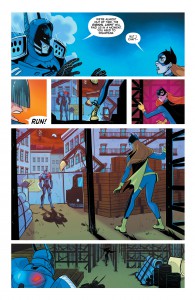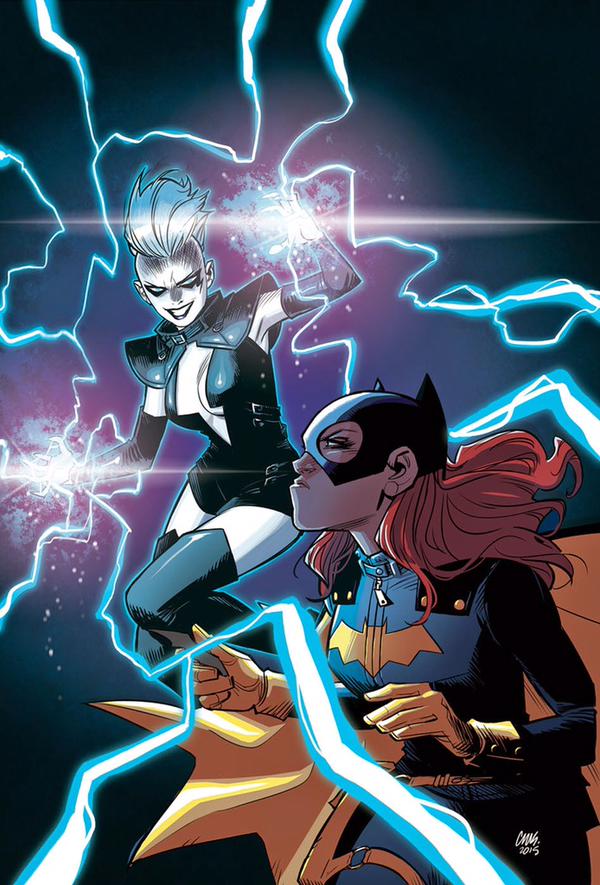
Written by Cameron Stewart and Brenden Fletcher
Art by Babs Tarr
Breakdowns by Jake Wyatt and Michel Lacombe
Colors by Serge Lapointe
Published by DC Comics
One of the things that writers Cameron Stewart and Brenden Fletcher and artist Babs Tarr have shown in their run on Batgirl is that Gotham can be home to other stories and genres other than dark conspiracy, horror, or detective tales. Batgirl #42 could be classified as a techno thriller comedy, or just a superhero yarn with an added personal layer because Barbara is teaming up with her dad even if they don’t know it. The art continues to be the biggest highlight, and Tarr’s lines continue to be sweeping and pretty, and her character models are quite adorable. Jake Wyatt and Michel Lacombe handle the layouts and showcase Batgirl’s speed and tenacity with swooping, diagonal panels even if a sequence in the big climactic fight sequence against Lightspeed is a little muddled. Colorist Serge Lapointe brings a bold, bright palette to the issue, but switches up his style for softer, happier scenes with Batgirl in her civilian life as well as going a little Post-Impressionist for the bits featuring Batman and the Gotham skyline.
Batgirl #42 has a relatively simple plot. The new Batman (who is Jim Gordon if you haven’t been keeping up with comics news for the past few months) attacks Batgirl for the first page, but then they become allies to some extent and fight Livewire together. Stewart and Fletcher don’t make Batgirl and Batman super buddies from the get go, and Tarr creates a little tension with a blue pencil flashback to Jim telling Barbara that he wouldn’t let her join the force so he could protect her. However, the comic isn’t all overprotective daddy issues, and Batgirl ends up teaching Batman a few things about being a bat themed vigilante with a Tarr drawn wink.
Batgirl #42 isn’t all fighting and shiny superpowers as Barbara and the new Oracle, Frankie, actually do their  homework on Livewire, who retains some of her Superman-related origin from the DC Animated Universe combined with a YouTube star gone bad. (This relevant in a time when Vine “stars” with millions of followers, like Nash Grier, are uttering homophobic slurs and generally behaving like scumbags.) Stewart and Fletcher use contemporary social media, but don’t let it overshadow the story and focus on Barbara and Frankie using their smarts to take out a more powerful foe. Livewire is a nice outlet for Tarr’s energetic art style, and she fills the page with crackles of electricity and equally kicks and acrobatic moves from Batgirl.
homework on Livewire, who retains some of her Superman-related origin from the DC Animated Universe combined with a YouTube star gone bad. (This relevant in a time when Vine “stars” with millions of followers, like Nash Grier, are uttering homophobic slurs and generally behaving like scumbags.) Stewart and Fletcher use contemporary social media, but don’t let it overshadow the story and focus on Barbara and Frankie using their smarts to take out a more powerful foe. Livewire is a nice outlet for Tarr’s energetic art style, and she fills the page with crackles of electricity and equally kicks and acrobatic moves from Batgirl.
Wyatt and Lacombe deserve some credit for making fight scenes that could be cluttered and confusing, kinetic and easy on the eyes. There is one page where four things are going on in the fight between Batgirl, Batman, and Livewire, but they make sure each piece of Tarr’s art is in place to show Batgirl and Batman’s easy chemistry. Unfortunately, this chemistry is hindered by the Powers Corporation’s mandate for Jim Gordon’s Batman to hunt down the other Gotham City vigilantes adding some more corporate conflict in a more subtle way. With Bruce Wayne out of the picture, the dynamic of Gotham is shaken up, and Stewart, Fletcher, and Tarr explore this change without skimping on Barbara’s personal story
Batgirl #42 examines the complicated relationship between Batgirl and the new Batman while still being a rip roaring superhero vs. supervillain battle royale with Babs Tarr’s bright artwork, touches of humor, and subtle uses of modern social media.

